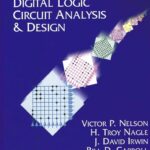توضیحات
Contents
Preface DO Introduction
0.1
History of Computing 0.1.1 Beginnings: Mechanical Computers 0.1.2 Early Electronic Computers 0.1.3 The First Four Generations of Computers 0.1.4 The Fifth Generation and Beyond
0.2
0.3
Digital Systems 0.2.1 Digital vs Analog Systems 0.2.2 Digital System Design Hierarchy Organization of a Stored Program Digital Computer 0.3.1 Computer Instructions 0.3.2 Information Representation in Computers 0.3.3 Computer Hardware 0.3.4 Computer Software
0.4
Summary
สี
สี
1 Number Systems and Codes
1.1 Number Systems
1.1.1 Positional Notation 1.1.2 Commonly Used Number Systems
สี สี
=
iv
Contents
1.2
Arithmetic
1.2.1 1.2.2 1.2.3
Binary Arithmetic Octal Arithmetic Hexadecimal Arithmetic
1.3
Base Conversions 1.3.1 Conversion Methods 1.3.2 General Conversion Algorithms 1.3.3 Conversion Between Base A and Base B When B = Ak
1.4
1.5
Signed Number Representation 1.4.1 Sign-Magnitude Numbers 1.4.2 Complementary Number Systems Computer Codes 1.5.1 Numeric Codes 1.5.2 Character and Other Codes 1.5.3 Error Detection Codes and Correction Codes
1.6
Summary
78
2 Algebraic Methods for the Analysis and Synthesis of Logic Circuits
2.1 Fundamentals of Boolean Algebra
2.1.1 Basic Postulates 2.1.2 Venn Diagrams for Postulates [2] 2.1.3 Duality 2.1.4 Fundamental Theorems of Boolean Algebra
2.2
93
Switching Functions 2.2.1 Truth Tables 2.2.2 Algebraic Forms of Switching Functions 2.2.3 Derivation of Canonical Forms 2.2.4 Incompletely Specified Functions
94
101
3
103
Contents
V
2.3
104
Switching Circuits 2.3.1 Electronic Logic Gates 2.3.2 Basic Functional Components
104 108
2.4
120
120 123
128
Analysis of Combinational Circuits 2.4.1 Algebraic Method 2.4.2 Analysis of Timing Diagrams Synthesis of Combinational Logic Circuits 2.5.1 AND-OR and NAND Networks 2.5.2 OR-AND and NOR Networks 2.5.3 Two-Level Circuits 2.5.4 AND-OR-invert Circuits 2.5.5 Factoring
128 130 131 133 134
2.6
Applications
136
2.7
140
Computer-Aided Design of Logic Circuits 2.7.1 The Design Cycle 2.7.2 Digital Circuit Modeling 2.7.3 Design Synthesis and Capture Tools 2.7.4 Logic Simulation
140 140 148 152
2.8
Summary
165
3 Simplification of Switching Functions
3.1 Simplification Goals
172 173
3.2
Characteristics of Minimization Methods
174
3.3
175
Karnaugh Maps 3.3.1 Relationship to Venn Diagrams and Truth Tables 3.3.2 K-Maps of Four or More Variables
176 177
vi
Contents
3.4
Plotting Functions in Canonical Form on the K-Map
179
3.5
Simplification of Switching Functions Using K-Maps 185 3.5.1 Guidelines for Simplifying Functions Using K-Maps 187 3.5.2 General Terminology for Switching Function Minimization
187 3.5.3 Algorithms For Deriving Minimal SOP Forms From K-Maps
188
3.6
197
POS Form Using K-Maps 3.6.1 General Terminology for POS Forms 3.6.2 Algorithms For Deriving Minimal POS Forms From
K-Maps
197
197
3.7
Incompletely Specified Functions
203
3.8
Using K-Maps To Eliminate Timing Hazards
206
3.9
211
Quine-McCluskey Tabular Minimization Method 3.9.1 Covering Procedure 3.9.2 Incompletely Specified Functions 3.9.3 Systems With Multiple Outputs
215 218 219
3.10
Petricks Algorithm
222
224
227
3.11 Computer-aided Minimization of Switching
Functions 3.11.1 Cube Representation of Switching Functions 3.11.2 Algebraic Methods for Determining Prime
Implicants 3.11.3 Identifying Essential Prime Implicants 3.11.4 Completing a Minimal Cover 3.11.5 Other Minimization Algorithms
228 230 231 234
3.12 Summary
234
Contents
vii
242
4 Modular Combinational Logic
4.1 Top-Down Modular Design
243
4.2
245
246 247
Decoders 4.2.1 Decoder Circuit Structures 4.2.2 Implementing Logic Functions Using Decoders 4.2.3 Enable Control Inputs 4.2.4 Standard MSI Decoders 4.2.5 Decoder Applications
249
252 253
4.3
259
Encoders 4.3.1 Encoder Circuit Structures 4.3.2 Standard MSI Encoders
260 264
4.4
268
268
Multiplexers/Data Selectors 4.4.1 Multiplexer Circuit Structures 4.4.2 Standard MSI Multiplexers 4.4.3 Applications of Multiplexers
270
277
4.5
Demultiplexers/Data Distributors
280
4.6
283
Binary Arithmetic Elements 4.6.1 Basic Binary Adder Circuits 4.6.2 MSI Binary Adder Modules 4.6.3 High-speed Adder Units 4.6.4 Binary Subtraction Circuits 4.6.5 Arithmetic Overflow Detection
283 285 289 294 295
4.7
Comparators
298
4.8
Design Example: A Computer Arithmetic Logic Unit 302
4.9
312
Computer-aided Design of Modular Systems 4.9.1 Design Libraries 4.9.2 Drawing Hierarchical Schematics
312 314
viii
Contents
4.10 Simulation of Hierarchical Systems
317
4.11 Summary
319
5 Combinational Circuit Design with Programmable Logic Devices
5.1 Semicustom Logic Devices
327
329
5.2
330
Logic Array Circuits 5.2.1 Diode Operation in Digital Circuits 5.2.2 AND and OR Logic Arrays 5.2.3 Two-Level AND-OR Arrays 5.2.4 Field-Programmable AND and OR Arrays 5.2.5 Output Polarity Options 5.2.6 Bidirectional Pins and Feedback Lines 5.2.7 Commercial Devices
330 332 333 338 341 343
345
5.3
347
Field-programmable Logic Arrays 5.3.1 FPLA Circuit Structures 5.3.2 Realizing Logic Functions With FPLAS
347 347
5.4
Programmable Read-only Memory
350
5.4.1 PROM Circuit Structures 5.4.2 Realizing Logic Functions With PROMs 5.4.3 Lookup Tables 5.4.4 General Read-only Memory Applications 5.4.5 Read-only Memory Technologies
350 352 358 360 361
5.5
362
Programmable Array Logic 5.5.1 PAL Circuit Structures 5.5.2 Realizing Logic Functions With PALS 5.5.3 PAL Output and Feedback Options
362 363 366
Contents
ix
5.6
Computer-aided Design Tools for PLD Design
371
5.6.1 Design Representation with PDL 5.6.2 Processing a PDL Design File
373 379
5.7
Summary
380
382
D 6 Introduction to Sequential Devices
6.1 Models for Sequential Circuits
6.1.1 Block Diagram Representation
6.1.2 State Tables and Diagrams 6.2 Memory Devices
383 383 385
387
6.3
389
Latches 6.3.1 Set-Reset Latch 6.3.2 Gated SR Latch 6.3.3 Delay Latch
389 396 398
6.4
Flip-Flops 6.4.1 Master-Slave SR Flip-Flops 6.4.2 Master-Slave D Flip-Flops 6.4.3 Master-Slave JK Flip-Flops 6.4.4 Edge-triggered D Flip-Flops 6.4.5 Edge-triggered JK Flip-Flops 6.4.6 T Flip-flops 6.4.7 Latch and Flip-flop Summary
403 404 406 407 409 413 415
417
6.5
Other Memory Devices
418
6.6
418
Timing Circuits 6.6.1 One-shots 6.6.2 The 555 Timer Module
418 418
6.7
Rapidly Prototyping Sequential Circuits
421
6.8
Summary
425
X
Contents
432
433
7 Modular Sequential Logic
7.1 Shift Registers
7.1.1 A Generic Shift Register 7.1.2 Standard TTL Shift-Register Modules
434 436
7.2
446
Design Examples Using Registers 7.2.1 Serial Adder Unit 7.2.2 Serial Accumulators 7.2.3 Parallel Accumulators
446 448 450
7.3
450
Counters 7.3.1 Synchronous Binary Counters 7.3.2 Asynchronous Binary Counters 7.3.3 Down Counters 7.3.4 Up/Down Counters
451 455 458 460
7.4
Modulo-N Counters
464
7.4.1 Synchronous BCD Counters 7.4.2 Asynchronous BCD Counters 7.4.3 Modulo-6 and Modulo-12 Counters 7.4.4 Asynchronously Resetting Modulo-N Counters 7.4.5 Synchronously Resetting Modulo-N Counters
464 467 470 474 477
7.5
477
Shift Registers as Counters 7.5.1 Ring Counters 7.5.2 Twisted-ring Counters
478 482
on
7.6
Multiple-sequence Counters
489
7.7
489
Digital Fractional Rate Multipliers 7.7.1 TTL Modules 7.7.2 Cascading the Digital Fractional Rate Multipliers
491 495
7.8
Summary
496
Contents Xi
502
503
504 505
507
507 508 517
519
8 Analysis and Synthesis of Synchronous Sequential Circuits
8.1 Synchronous Sequential Circuit Models
8.1.1 Mealy Model
8.1.2 Moore Model 8.2 Sequential Circuit Analysis
8.2.1 Analysis of Sequential Circuit State Diagrams 8.2.2 Analysis of Sequential Circuit Logic Diagrams
8.2.3 Summary 8.3 Synchronous Sequential Circuit Synthesis
8.3.1 Synthesis Procedure 8.3.2 Flip-flop Input Tables 8.3.3 Application Equation Method for JK Flip-flops 8.3.4 Design Examples 8.3.5 Algorithmic State Machine Diagrams
8.3.6 One-hot Finite-State Machine Design Method 8.4 Incompletely Specified Circuits
8.4.1 State Assignment and Circuit Realization 8.5 Computer-aided Design of Sequential Circuits
8.5.1 Design Capture and Synthesis 8.5.2 Design Analysis and Verification
520 522 524 526 547 553
555
558
558
559
565
8.6
Summary
568
576
577
577
9 Simplification of Sequential Circuits
9.1 Redundant States
9.1.1 State Equivalence
9.1.2 Equivalence and Compatibility Relations 9.2 State Reduction in Completely Specified Circuits
9.2.1 Inspection
579
579
579
xii
Contents
9.3
9.2.2 Partitioning 9.2.3 Implication Table State Reduction In Incompletely Specified Circuits 9.3.1 State Compatibility 9.3.2 Minimization Procedure
581 584 588 589 594
9.4
Optimal State Assignment Methods
602
9.4.1 Unique State Assignments 9.4.2 State Assignment Guidelines 9.4.3 Partitioning 9.4.4 Optimal State Assignments
603 605 614
619
9.5
Summary
620
624
10 Asynchronous Sequential Circuits
10.1 Types of Asynchronous Circuits 10.2 Analysis of Pulse-mode Asynchronous Circuits
625
627
632
632
10.3 Synthesis of Pulse-mode Circuits
10.3.1 Design Procedure for Pulse-mode Circuits 10.4 Analysis of Fundamental-mode Circuits
10.4.1 Introduction 10.4.2 Tabular Representations 10.4.3 Analysis Procedure
641
645 648
648
10.5 Synthesis of Fundamental-mode Circuits
10.5.1 Synthesis Procedure
648
659
660
10.6 Introduction to Races, Cycles, and Hazards
10.6.1 Races and Cycles 10.6.2 Avoidance of Race Conditions 10.6.3 Race-free State Assignments 10.6.4 Hazards 10.6.5 Analysis
663 664
671
673
Contents
xiii
10.7 Summary
673
686
687
11 Sequential Circuits With Programmable Logic Devices
11.1 Registered Programmable Logic Devices
11.1.1 Field-Programmable Logic Sequencers 11.1.2 Registered PALS 11.1.3 PLDs with Programmable Logic Macrocells
691 696 700
702
705 713
11.2 Programmable Gate Arrays
11.2.1 Logic Cell Arrays
11.2.2 ACT FPGAs 11.3 Sequential Circuit Design and PLD Device Selection 11.4 PLD Design Examples
715
717
723
11.5 Computer-aided Design of Sequential PLDs
11.5.1 Sequential Circuit Design Representation with PDL 11.5.2 Processing a PDL Design File
729
11.6 Summary
733
738
12 Logic Circuit Testing and Testable Design
12.1 Digital Logic Circuit Testing
739
12.2 Fault Models
740
741
742
751
12.3 Combinational Logic Circuit Testing
12.3.1 Test Generation 12.3.2 Untestable Faults 12.3.3 Multiple Output Networks 12.3.4 Fault Detection Test Sets 12.3.5 Fault Location and Diagnosis 12.3.6 Random Testing
752 753 757
758
xiv
Contents
12.4 Sequential Logic Circuit Testing
760
12.5
763
Design For Testability 12.5.1 Scan Path Design
764
12.6
Built-in Self-test
768
769
12.6.1 12.6.2 12.6.3
Pseudorandom Test Vector Generation Signature Analysis Built-In Logic Block Observer
772 775
12.7 Board and System-level Boundary Scan
777
12.8 Summary
781
788
789
13 Design Examples
13.1 Electronic Slot Machine
13.1.1 Problem Definition 13.1.2 System Requirements and Solution Plan 13.1.3 Logic Design
789 790
792
801
13.2 Keyless Auto Entry System
13.2.1 Problem Definition 13.2.2 System Requirements 13.2.3 Logic Design
801 803
805
810
13.3 One-lane Traffic Controller
13.3.1 System Requirements 13.3.2 Logic Design
813 815
821
13.4 Grocery Store Cash Register
13.4.1 System Requirements 13.4.2 Logic Design
823 824
Index
833
Preface
- لینک دانلود فایل بلافاصله بعد از پرداخت وجه به نمایش در خواهد آمد.
- همچنین لینک دانلود به ایمیل شما ارسال خواهد شد به همین دلیل ایمیل خود را به دقت وارد نمایید.
- ممکن است ایمیل ارسالی به پوشه اسپم یا Bulk ایمیل شما ارسال شده باشد.
- در صورتی که به هر دلیلی موفق به دانلود فایل مورد نظر نشدید با ما تماس بگیرید.
 مرجع دانلود فایل | مرجع دانلود فایل
مرجع دانلود فایل | مرجع دانلود فایل


هنوز هیچ نقد و بررسی وجود ندارد.